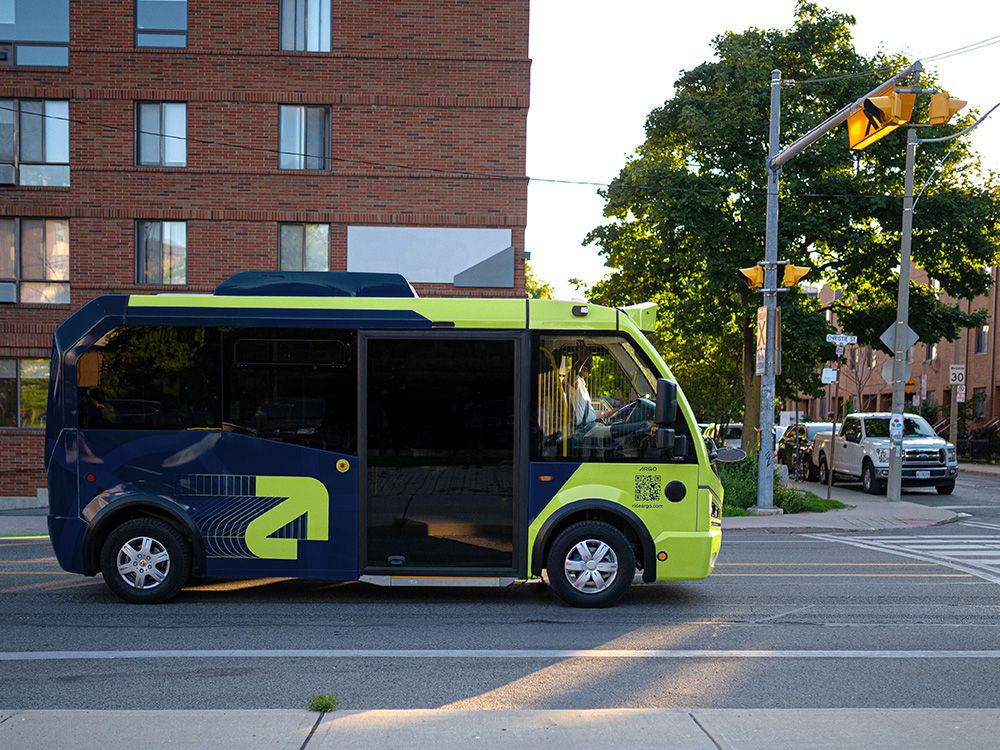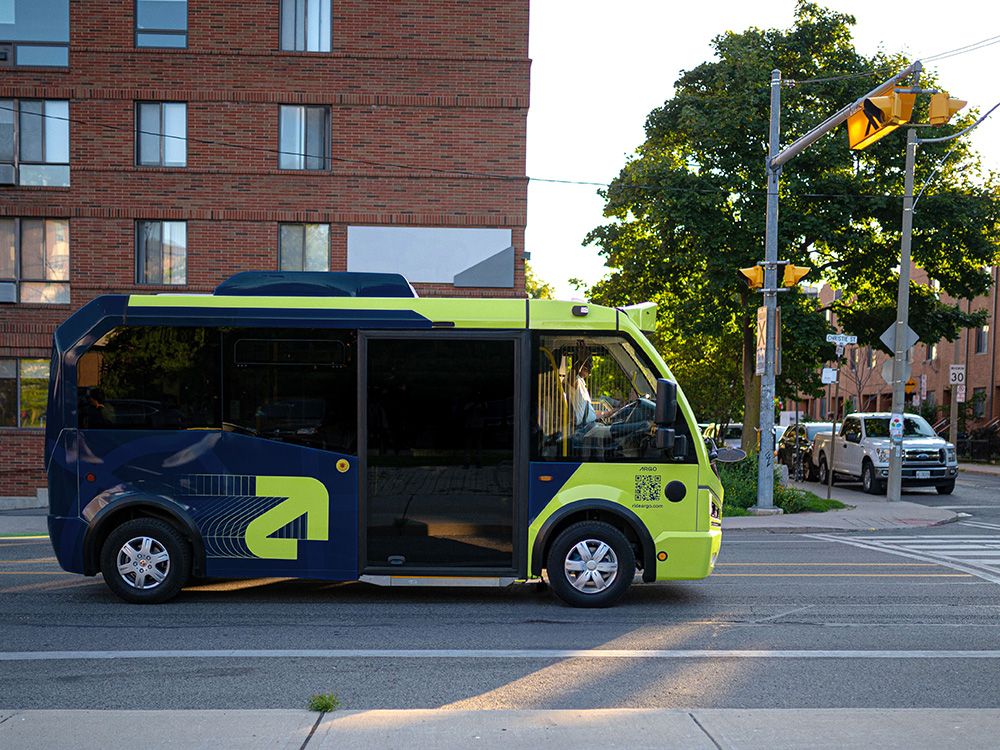
Traffic congestion is reaching crisis levels across Canada’s largest urban regions, threatening the economy and eroding quality of life for millions. From Toronto’s notorious Highway 401 bottleneck — costing commuters over three million hours of delay each year — to traffic jams in Montreal and Vancouver, the country’s major corridors are consistently among the worst in North America.
One upstart, Argo, hopes to mitigate the problem with a made-in-Canada public transit concept.
Argo integrates with existing transit lines and fare systems, an approach that could serve as a template for municipalities from coast to coast, supporting federal and provincial goals to cut emissions, boost economic productivity, and improve access to jobs, health care and education.
Argo’s new busing line allows users to request a transit ride near their location, with an app or phone call. Argo’s smart routing system groups passengers going the same way. The rider is then taken to an existing transit connection, or close to their final destination — all under one standard fare.
In the three months since launching its service in Bradford West Gwillimbury, Ont., Argo doubled ridership, having now replaced all fixed bus routes once operated by a private contractor.
This summer, Argo will roll out a 12-month pilot in Brampton, Ont., complementing an existing transit network with Brampton Transit and GO lines.
Praveen Arichandran speaks to the National Post’s Dave Gordon about Argo Corporation, the Toronto-based publicly traded company he co-founded last year. With degrees in computer engineering and economics from the University of Waterloo, Arichandran previously served as Tesla’s head of growth, and on Facebook’s international growth team. He was named to Forbes’ global “30 Under 30” list in 2019, and served as a key adviser to TikTok.
What’s unique about Argo?
We are building a future where public transit is more convenient than driving, but as affordable as taking the bus. We fully integrate with existing transit lines and fare systems, so that integration lets us deliver faster deployments, lower costs and a better quality of service. We’re dynamically routing our vehicles and grouping riders intelligently.
I think more broadly for society, that means a future where access to jobs, health care, education and our loved ones is democratized, and not just limited to those who can afford car payments, real estate next to major transit lines, or those mobile enough to walk to the bus stop and wait in the cold for the bus. Argo vehicles are fully electric and wheelchair accessible with an 18-passenger capacity.
How would a rider save time or money with Argo?
With traditional public transit, half of the time spent in transit is spent on 10 per cent of the distance. This is the “first and last mile” problem, of getting to and from a fixed route transit line, and waiting for the bus or the train.
With a typical ride share service, you get picked up directly at your door with a private driver, but the cost of that is prohibitive for most people to rely on for day-to-day mobility. So our smart routing technology dynamically routes the buses, and groups riders efficiently, so people can get picked up near their door, while still paying a standard transit fare, with the economics of traditional public transit.
How would Argo work in areas underserved by traditional public transit, and how do you integrate with those existing transit networks?
There are places in the city where public transit is less prevalent. That’s exactly the problem that our solution is best for. So regardless of whether there’s a high level of existing public transit lines in the area or a very low level, our system can dynamically route and pick people up near their door. And if it’s an area with sparse existing transit coverage, then our system can carry the full burden of the transit experience … we’ll take them all the way to their final destination.
This is a solution for municipalities where a transit line needs to run every 20 minutes, though there isn’t enough demand. In areas where there are existing high capacity transit lines, then we’ll focus more on solving that “first and last mile,” and feeding people into those transit lines.

It’s a hard technical problem to solve, because you need the hardware, the software, the routing, the operations, the supply, demand management. There’s a lot of technical complexity to building a system like this.
But you need a place where you can bridge the technical talent that can build something like this with a public-sector ecosystem that is willing to invest in innovation.
We work to partner with all levels of government in order to make that happen. We’re in active conversations with many other transit agencies to ensure that we can collaborate and solve this problem together.
How would Argo scale to larger municipalities?
It does require a combination of world-class technology talent, and a public-sector ecosystem willing to invest in that innovation. We’ve brought home some of the top executives and engineers from leading consumer technology and mobility companies. But in order to scale both through Canada and globally, we’re really excited to partner with all levels of Canadian government as we build a global standard for modern transportation infrastructure.
What kind of investment will governments offer?
The Ontario Ministry of Transportation has said publicly it’ll spend $100 billion in the next decade on transportation infrastructure, and we believe that investment in innovation and solutions, like Argo, can deliver to the taxpayer extremely high ROI.
The municipality is already spending in partnership with the provincial and federal government, on transit infrastructure. So the value for the dollar, both from a capital perspective and an operational perspective, is more efficient than the alternatives, and can get reduced congestion, and help people have increased levels of access.
Can you describe the success so far?
Even the most robust transit networks in the country, for many people, aren’t accessible. Those who have mobility issues, and have trouble getting to the bus stop. Those who work off hours and on fixed route systems, have reduced service levels.
Even a healthy and active 25-year-old in a major city would find walking to the bus stop in the peak of winter, waiting for a bus, a major limiting factor to their mobility.
So in BWG (Bradford West Gwillimbury), we’ve seen so many inspiring examples of people who previously were isolated from their communities, finally being able to participate in society.
There’s a personal support worker who used to ride rideshare to and from work every day. She now can get to and from work for $1 each way, which is the transit fare, but now she can take her clients, many of whom have dementia or mobility issues, and have just been isolated in their homes for months at a time and just don’t have the ability to leave their homes. Now she’s taking them to the park, into the community centre and out to the mall.
There’s teachers who’ve been taking their special-needs kids out into town, just swimming in the community centre. There’s parents with disabilities. There’s a woman we met who has epilepsy who can’t drive, who can finally take her kids around town. There’s small business owners, a gentleman who produces honey locally, who now offers free delivery within the community during Argo service hours.
How does Canada win with Argo?
We are built and headquartered in Canada, so we’re repatriating several high-profile global technology executives and engineers. We’re creating a solution to a global challenge that Canada can export.
This interview has been edited for brevity.
This is the latest in a National Post series on How Canada Wins. Read earlier instalments here.
Our website is the place for the latest breaking news, exclusive scoops, longreads and provocative commentary. Please bookmark nationalpost.com and sign up for our daily newsletter, Posted, here.
